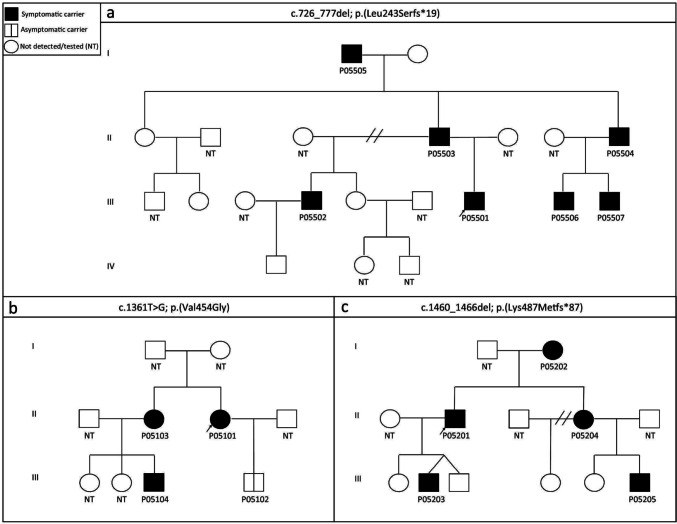Fig. 2.
Family trees of HAE patients. HAE-affected family members carrying the causal variant are shown in black, Asymptomatic/presymptomatic carriers of causal variants are depicted by a partitioned symbol, and healthy individuals are depicted by a blank symbol. Individuals who were not tested are signified by NT. a The variant c.726_777del was identified in 7 members of one family with HAE-1. The variant was first revealed in a 10-year-old boy (P05501) and his father, who both showed relatively severe HAE symptoms, and their condition started at a young age, at 9 and 7 years, respectively. Further genetic analysis revealed the same variant in another 4 members of the family. Interestingly, the oldest member of the family—an 81-year-old grandfather (P05505) of this 10-year-old boy—suffered from only 2 attacks in his life, both appearing before establishing his diagnosis perioperatively at 68 and 73 years of age. His C1-INH and C4 levels, and C1-INH function were normal. All other members with the detected variant had low C4 and C1-INH levels as well as C1-INH function, and all of them also showed HAE symptoms. 4 asymptomatic members with normal C4 and C1-INH levels were tested, and the variant was not detected in their DNA samples. b The variant p.Val454Gly was among other patients also found in 4 members of the depicted family. Three family members (P05101, P05103 and P05104) suffered from HAE attacks and also showed laboratory HAE symptoms, whereas 29-year-old P05102 showed only C1-INH concentration and function deficit with no clinical symptoms of HAE. c Seven base pair deletion c.1460_1466del was detected in a family with 5 patients. The HAE phenotype in this family segregates with the presence of the variant and the disease course is quite severe in all affected members—in P05205, the attacks appeared as early as 2 years of age. The variant was not found in 4 other asymptomatic family members tested

